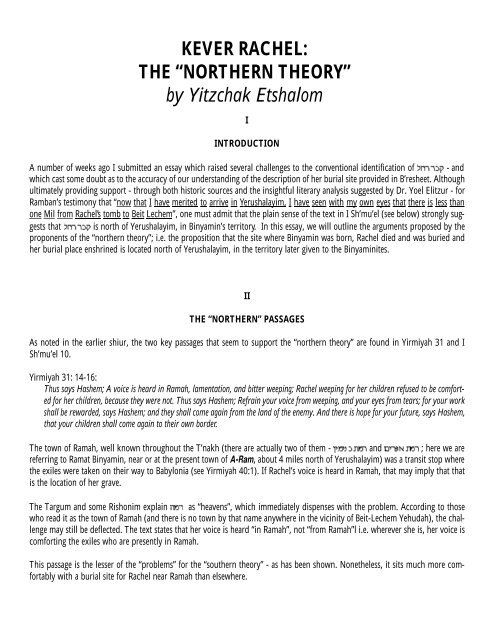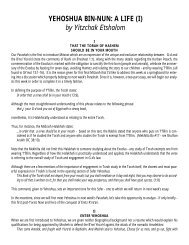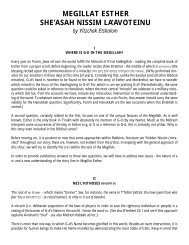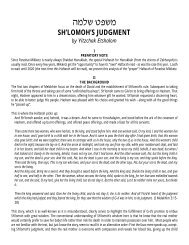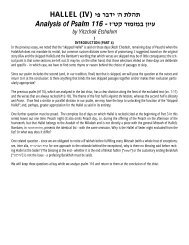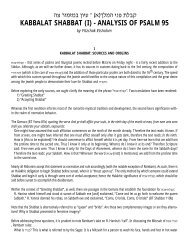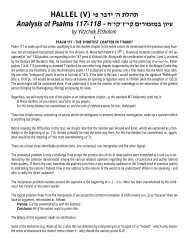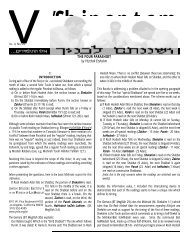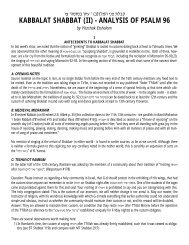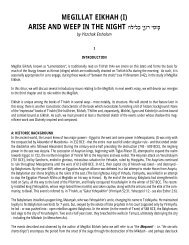KEVER RACHEL: THE âNORTHERN THEORYâ by ... - Torah.org
KEVER RACHEL: THE âNORTHERN THEORYâ by ... - Torah.org
KEVER RACHEL: THE âNORTHERN THEORYâ by ... - Torah.org
Create successful ePaper yourself
Turn your PDF publications into a flip-book with our unique Google optimized e-Paper software.
<strong>KEVER</strong> <strong>RACHEL</strong>:<strong>THE</strong> “NOR<strong>THE</strong>RN <strong>THE</strong>ORY”<strong>by</strong> Yitzchak EtshalomIINTRODUCTIONA number of weeks ago I submitted an essay which raised several challenges to the conventional identification of - andwhich cast some doubt as to the accuracy of our understanding of the description of her burial site provided in B’resheet. Althoughultimately providing support - through both historic sources and the insightful literary analysis suggested <strong>by</strong> Dr. Yoel Elitzur - forRamban’s testimony that “now that I have merited to arrive in Yerushalayim, I have seen with my own eyes that there is less thanone Mil from Rachel’s tomb to Beit Lechem”, one must admit that the plain sense of the text in I Sh’mu’el (see below) strongly suggeststhat is north of Yerushalayim, in Binyamin’s territory. In this essay, we will outline the arguments proposed <strong>by</strong> theproponents of the “northern theory”; i.e. the proposition that the site where Binyamin was born, Rachel died and was buried andher burial place enshrined is located north of Yerushalayim, in the territory later given to the Binyaminites.II<strong>THE</strong> “NOR<strong>THE</strong>RN” PASSAGESAs noted in the earlier shiur, the two key passages that seem to support the “northern theory” are found in Yirmiyah 31 and ISh’mu’el 10.Yirmiyah 31: 14-16:Thus says Hashem; A voice is heard in Ramah, lamentation, and bitter weeping; Rachel weeping for her children refused to be comfortedfor her children, because they were not. Thus says Hashem; Refrain your voice from weeping, and your eyes from tears; for your workshall be rewarded, says Hashem; and they shall come again from the land of the enemy. And there is hope for your future, says Hashem,that your children shall come again to their own border.The town of Ramah, well known throughout the T’nakh (there are actually two of them - and ; here we arereferring to Ramat Binyamin, near or at the present town of A-Ram, about 4 miles north of Yerushalayim) was a transit stop wherethe exiles were taken on their way to Ba<strong>by</strong>lonia (see Yirmiyah 40:1). If Rachel’s voice is heard in Ramah, that may imply that thatis the location of her grave.The Targum and some Rishonim explain as “heavens”, which immediately dispenses with the problem. According to thosewho read it as the town of Ramah (and there is no town <strong>by</strong> that name anywhere in the vicinity of Beit-Lechem Yehudah), the challengemay still be deflected. The text states that her voice is heard “in Ramah”, not “from Ramah”l i.e. wherever she is, her voice iscomforting the exiles who are presently in Ramah.This passage is the lesser of the “problems” for the “southern theory” - as has been shown. Nonetheless, it sits much more comfortablywith a burial site for Rachel near Ramah than elsewhere.
I Sh’muel 10:1-6Then Sh’mu’el took a vial of oil, and poured it upon his head, and kissed him, and said, Is it not because Hashem has anointed you to becaptain over his inheritance? When you part from me today, then you shall find two men <strong>by</strong> the tomb of Rachel ( ) in the borderof Binyamin at Zelzah; and they will say to you, “The donkeys which you went to seek have been found; and, behold, your father hasceased to care about the donkeys, and has become anxious about you, saying, What shall I do about my son?” Then shall you go on forwardfrom there, and you shall come to Elon Tavor, and there you shall be found <strong>by</strong> three men going up to G-d to Beit-El, one carryingthree kids, and another carrying three loaves of bread, and another carrying a skin of wine; And they will greet you, and give you twoloaves of bread; which you shall receive from their hands. After that you shall come to the Giv’at ha’Elokim, where the garrisons of thePhilistines are; and it shall come to pass, when you have come there to the city, that you shall meet a company of prophets coming downfrom the high place with a lute, and a tambourine, and a pipe, and a lyre, before them; and they shall prophesy; And the spirit of Hashemwill come upon you, and you shall prophesy with them, and shall be turned into another man.This passage is much more challenging and is the wedge used <strong>by</strong> anyone trying to promote the “northern theory.” Sh’mu’el wasspeaking to Sha’ul in Ramah (the one in Binyamin) and telling him about three wondrous things he would experience on his wayhome - to Giv’ah. Giv’ah (identified with present-day Jaba) is also in Binyamin, a few miles southeast of Ramah. If he was goingto meet people at on the way home, then is not only north of Yerushalayim, but we can even identify, withsome accuracy and confidence, its exact location. In spite of the creative manner in which Dr. Elitzur interpreted the sequencingof these signs, restoring Kever Rachel to its southern site, the simplest read of this text places Kever Rachel in Binyamin’s territory.Before continuing, we should note that the bulk of Midrashic literature supports the “northern theory” and needs to be explained- somewhat forcefully in places - to conform to the conventional approach. The interested reader is encouraged to reviewV’shinantam 5/8 for a full presentation of that material.IIIYIRMIYAHU AND <strong>THE</strong> RIVER “P’RAT”Our solution begins far from the passages which are central to the Rachel narrative - and, a priori, quite a distance from either proposedlocation for her tomb.In Yirmiyah 13, we read of a command given to the prophet:Thus says Hashem to me, Go and get a linen girdle, and put it upon your loins, and put it not in water. So I got a girdle accordingto the word of Hashem, and put it on my loins. And the word of Hashem came to me the second time, saying, Take the girdlethat you have got, which is upon your loins, and arise, go to , and hide it there in a hole of the rock. So I went, andhid it in , as Hashem commanded me. And it came to pass after many days, that Hashem said to me, Arise, go to , andtake the girdle from there, which I commanded you to hide there. Then I went to , and dug, and took the girdle from theplace where I had hidden it; and, behold, the girdle was spoiled, it was good for nothing. (vv. 1-7)The working assumption, adopted <strong>by</strong> most of the classical commentators, is that theEuphrates River.here is the “famous” one - i.e. theThis prophecy, in which Yirmiyah is commanded to fulfill an action which will serve as a symbol of what will befall the people ifthey do not mend their ways (see the rest of the chapter), is not unusual in that particular regard. As Ramban (B’resheet 12:6)explains:“...know that when [divine decrees] pass from a potential decree to a symbolic act, the decree will in any case be effected. Itis for this reason that the prophets often perform some act in conjunction with the prophecies, just as Yirmiyah commandBarukh, his student: And it shall be, when you have made an end of reading this book, that you shall bind a stone to it, and cast it intothe midst of the P’rat, and you shall say: Thus shall Bavel sink (Yirmiyah 51:63-64). Likewise in the matter of Elisha when he put
his arm on the bow [held <strong>by</strong> Yo’ash, king of Yisra’el]: And Elisha said: Shoot! And he shot. And he said: The Eternal’s arrow of victory,even the arrow of victory against Aram. (II Melakhim 13:17).The difficulty here is one of distance - and geology. Is it reasonable that Yirmiyah would be commanded to travel over 700 milesto the Euphrates river, in order to fulfill this symbolic action - then return home, then cover that distance again to retrieve the girdle- and return a second time? In addition, the Euphrates Valley is lush and green, there are no (the word for rock used inthe verse) at water’s edge.Solving thebook into the-riddle will also, incidentally, help us understand the last passage cited <strong>by</strong> Ramban, where Barukh is told to cast the. We will return to the problem and its solution after a brief but critical interlude.IVANCIENT TEXTS AND MODERN MINDSAs I mentioned in an earlier issue, much has been made of late (especially in our community this past year ) of the inevitability ofa clash between traditional attitudes towards the text of T’nakh and academic disciplines developed and honed over the past threehundred years. Popular wisdom (an oxymoron if there ever was one) holds that no one who embraces the methodology of literaryanalysis on the one hand, and archeology and its sister sciences on the other hand, could honestly maintain the traditional approachto the text. Put more bluntly, the common claim is that traditionalists must bury their collective heads in the sand in order to maintaintheir beliefs.Nothing could be further from the truth. Much of this claim rests on faulty assumptions about both sides of the coin. Traditionalapproaches to the text vary, have some measure of flexibility and are (at least in our tradition) far from “fundamentalist”. Conversely,both literary criticism and archeology are much more speculative than is commonly believed - there is much more eisegesis (readinginto the text what the reader wishes to impute) than honest exegesis (inferring from the text that which is likely the true meaning).We will yet return to this topic in a later issue.When it comes to archeology, there is a general confusion as to the nature and purpose of this area of the study of the past.Archeology was never intended as a method of proving what did and didn’t take place in the ancient world - rather to use findingsto help understand the realia of that world, to find urban, climactic, numismatic (and so on) clues which would help to sharpenour view of the past as we know it - or to assist us in fine-tuning our understanding of the ancient world.Those “new archeologists” who have recently used their shovels to try to bury the T’nakh have been, <strong>by</strong> and large, been discounted<strong>by</strong> their colleagues (and even their students) - religious and secular alike. (Unfortunately, they have also made “headlines” whichself-appointed spokespersons for Judaism have avidly read and transmitted to their constituents, leading to much confusion anddarkness).In the meantime, those earnest and honest students of the T’nakh who are motivated <strong>by</strong> a true desire to understand the text - andit should be noted that there are many secular students of T’nakh who approach it with reverence and a passion for uncovering itstruths - have found that both literary criticism and the wonderful developments in the areas of literary analysis as well as the marvelous“underground life” revealed <strong>by</strong> the archeologist’s spade have done so much to help us understand the T’nakh on its ownterms. The overwhelming majority of articles in academic journals that specialize in these areas of Biblical studies are focused onidentifying the ancient roots of , the socio-religious background for the piercing of a slave’s ear etc. Significantly, many of theclaims suggested <strong>by</strong> the Rishonim, oft ridiculed <strong>by</strong> an earlier generation of “academicians”, have been substantiated <strong>by</strong> recent finds.I will present several examples of this phenomenon in a later essay.What was said above, as noted, holds true for all of those who love and revere the text on its own terms. For those of us who, in
addition, understand the text to be D’var Hashem, we take the passion for truth one critical step further. We not only enjoy gaininggreater understanding and perhaps revealing the meaning of heretofore mysterious passages, we understand it to be a religiousobligation of the highest degree. What can serve the communication of Hashem’s word to the world more than the proper elucidationof the text?This must, of course, be undertaken with a great sense of humility and trepidation - but the knowledge that we are dwarfs standingatop the shoulders of the giants of the generations, guided <strong>by</strong> our Mesorah (so that we won’t jump to the shoulders of someother giant) and every aware of our responsibilities as interpreters of the text (so that shan’t f<strong>org</strong>et upon whose shoulders we stand)gives us security and comfort, as well as a constant prod to delve further, ask more probing questions and dig deeper to understandthe text.It is in the spirit of that Avodat Hashem that we undertake to present the less-popular theory regarding the location of -not to diminish, but to enhance, our appreciation and love for Torat Hashem and to explore every available avenue to understandingits depths.VEPHRATAH = BEIT LEHEMThe textual cornerstone of the “southern theory” is the location of mentioned in the narrative (B’resheet 35:19) and repeated<strong>by</strong> Ya’akov on his deathbed (ibid. 48:7) -And as for me, when I came from Padan, Rachel died <strong>by</strong> me in the land of Canaan in the way, when yet there was to cometo Ephrath; and I buried her there in the way of Ephrath; which is is Beth-Lehem.One of the critical points of interpretation is the meaning of . Although the Midrashim have used the phrase to identifythe season of Binyamin’s birth - based on various agricultural allusions in that abstruse phrase - most of the Rishonim understoodit to be a measure of distance (see, inter alia, the above-cited comment of Ramban [B’resheet 35:19] in its entirety). Given that, themost reasonable explanation of Kiv’rat Derekh is “a small way” (perhaps a mile or two) - as Ramban testifies. This would seem toseal the location of in the south - unless we can succeed in finding an alternate location for “Ephrat, which is Beit Lehem”.As a starting point, it should be noted that there is more than one town named in Eretz Yisra’el; Zevulun inherits, amongits cities, the town of (Yehoshua 19:15) - and Zevulun’s territory is far to the north. This is easily understood, since awas given that name due to its location amid wheat and barley fields. The town was the central locus for trade and processingof wheat and barley (as highlighted in Megillat Ruth). Hence, any area rich in grains would likely have, at its hub, a town named.There is one referent omitted in the two passages in B’resheet that is notable - when referring to the “famous” Beit-Lehem, the textoften clarifies its identification <strong>by</strong> appending “Yehudah” (see Shoftim 17 & 19:). Both references in B’resheet notethe proximity of Beit Lehem to Ephrat - but leave out the more familiar “Yehudah”. (This may be a moot point, since Yehudah wasnot yet given that land at this point - see, however, V’shinantam 5/3 where the mention of tribal inheritances in B’resheet is discussedat length.)Instead of beginning our search from , let’s start from the other landmark in the verse - .A few miles north of Yerushalayim, there is a spring that was, well into the 20 th century, a main source of drinking water for thecity. The spring is called “Ein-Farah” - which most Biblical geographers and cartographers identify with the city of mentionedamong the cities of Binyamin (Yehoshua 18:23). It is not unreasonable to posit that /Ein-Farah was alternatively called
(identical root and meaning -, meaning “fruitful”).Modern commentators (including those traditional students of the text who embrace the findings of cartographers, archeologistsand the like in enhancing our understanding of the text) have long held that the where Yirmiyahu was commanded to hidehis girdle is none other than Ein-Farah (see Da’at Mikra to Yirmiyah 13). This spring is bounded <strong>by</strong> the type of rocks called S’la’imin T’nakh, and the obvious word-association of with makes the symbolism that much more accessible. Hence, whenBarukh is commanded to throw the scroll into the , he actually threw it into the spring at Farah. Due to the morphological association,that could serve to symbolize the fall of Bavel, bordered <strong>by</strong> the “other” .It is likely that this area, lush and well-watered, was surrounded <strong>by</strong> healthy and abundant crops and may have served as a- indeed, among the list of Shavei Tziyyon who returned to the cities of Binyamin in 536 BCE we find:The men of Beth-Lehem and Netophah, a hundred and eighty eight. (Nehemiah 7:26)Thus, it is well within reason to suppose a town named built around the spring of - a town which was later renamedon account of the grain processing center which developed around there. This would explain the phrase Ephrat which isBeit Lehem. The convention of place-identification in T’nakh is to first use the ancient name and then associate it - for the contemporaryaudience - with the later name. For example:And the border went over from there toward Luz, to the side of Luz, which is Beth-El (Yehoshua 18:13)...Remember, from B’resheet, that the ancient name of the town was Luz until Ya’akov renamed it Beit-El (B’resheet 28:19).In sum, we have found a likely candidate for Ephrat/Beit-Lehem in the area just north of Yerushalayim, directly in the route ofSha’ul’s return home and very near the Ramah mentioned <strong>by</strong> Yirmiyah.VIYA’AKOV’S ROUTEThe theory presented above was advanced <strong>by</strong> Nogah Hareuveni, an important contributor to the study and understanding ofT’nakh in our day. Hareuveni founded and directs N’ot K’dumim, an outdoor educational center for the study of the realia ofT’nakh. In his book Or Hadash al Sefer Yirmiyah, Hareuveni addressed the problematic Ramah-association in Yirmyah andrecalled, in a sort of nostalgic pastorale, a walk through the land of Binyamin before 1948 when he encountered the spring at Farahand was struck <strong>by</strong> the possible solution outlined in the previous section.In promoting his theory, the author has to address another challenge from realia. The ancient road from Sh’khem to Hevron, whichpasses directly through Beit-El (today the Arab village of Betin), remains atop the crest of the mountains in a fairly straight northsouthline. That road also passes directly through Beit Lehem Yehudah. At the time of Binyamin’s birth and Rachel’s death, Ya’akovwas moving, with his family, servants and livestock, south from Beit El towards Hevron (cf. B’resheet 35:27). If we accept the southerntheory, we understand the location - it’s right on the route to Hevron. If, however, we buy into the “northern theory”, what isYa’akov and his camp doing several miles east - and downhill - from the main road?Hareuveni argues that realia actually supports his contention. Ya’akov was not traveling alone; he had children, a pregnant wife andlots of livestock. As Ya’akov himself said to Esav:And he said to him, My lord knows that the children are tender, and the flocks and herds with young are with me; and if men should overdrivethem one day, all the flock will die. Let my lord, I beg you, pass over before his servant; and I will lead on slowly, according to thepace of the cattle that goes before me and the children are able to endure (33:13-14)It would not be practical to march the camp directly on the hilltop route without finding a suitable spot for his beloved wife togive birth. Here, a few miles off the road, was the well-known spring of, surrounded <strong>by</strong> its grape arbors and lush
fields. Ya’akov undoubtedly left the road to bring his camp to for this momentous event - the birth of his only son to be bornin the Land - and the only one to be a (the rest were all ).- and herein lies the final mystery to be unrav-The text, however, testifies that she gave birth some distance from Farah -eled <strong>by</strong> Hareuveni’s claim.VIIKUBUR BANI ISRA’ILApproximately 3 miles west-northwest of Farah there were five identical stone structures, measuring about 50 feet <strong>by</strong> 10 feet.(“were” because one of them was taken down to make way for the <strong>by</strong>pass road around Ramallah erected in the late 1980’s). Thesestructures serve no obvious purpose - commerce, abode or worship - and have always been called Kubur Bani Isra’il <strong>by</strong> the locals.I visited the site this past January - it is right off of the <strong>by</strong>pass road - and noted that it rests on the incline down towards Farah.For many years, archeologists and students of the Land have wondered what to make of these structures and why the indigenouspopulation (whose traditions of place-names have been a critical key in unlocking the identification of Biblical sites) insisted thatthis location was known as Kubur Bani Isra’il - i.e.(the tombs of the B’nei Yisra’el). Dr. Elitzur told me that whileleading a tour of the site, an ancient Arab came <strong>by</strong> and when asked the name, he replied Kubur Bani Isra’il. When asked the meaningof the name, he shrugged and said: “My grandfather called it <strong>by</strong> that name, his grandfather called it <strong>by</strong> that name...”Hareuveni’s theory is like an onion; each mystery that unravels opens another, which in turn makes itself accessible. He suggeststhat Kubur Bani Isra’il is none other than the tombstone of , which later generations of Jews used as a burial site.According to this version of the “northern theory”, not only do all of the verses fall into place - using our new, surprising “northern”Beit-Lehem/Ephrat - but the identity of these odd structures suddenly becomes clear.l,ru,c ubhbhg rtvu


